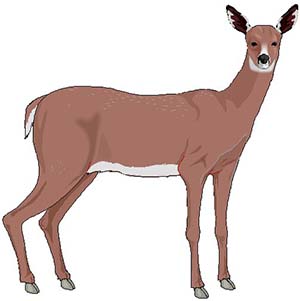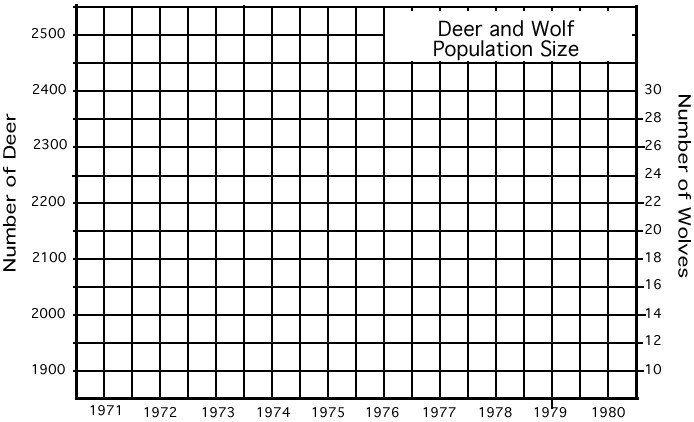Deer: Predation or Starvation?

Introduction: In 1970 the deer population of an island forest reserve about 518 square kilometers in size was about 2000 animals. Although the island had excellent vegetation for feeding, the food supply obviously had limits. Thus the forest management personnel feared that overgrazing might lead to mass starvation.
Since the area was too remote for hunters, the wildlife service decided to bring in natural predators to control the deer population. It was hoped that natural predation would keep the deer population from becoming too large and also increase the deer quality (or health), as predators often eliminate the weaker members of the herd. In 1971, ten wolves were flown into the island.
The results of this program are shown in the following table. The population change is the number of deer born minus the number of deer that died during that year. Fill out the last column for each year (the first has been calculated for you).
Year Wolf Population Deer Population Deer Offspring Predation Starvation Deer Population Change 1971 10 2,000 800 400 100 +300 1972 12 2,300 920 480 240 1973 16 2,500 1,000 640 500 1974 22 2,360 944 880 180 1975 28 2,224 996 1,120 26 1976 24 2,074 836 960 2 1977 21 1,948 788 840 0 1978 18 1,896 766 720 0 1979 19 1,862 780 760 0 1980 19 1,882 790 760 0
Graph the deer and wolf populations on the graph below. Use one color to show deer populations and another color to show wolf populations.

Analysis
1. Describe what happened to the deer population between 1971 and 1980.
2. When was the wolf population the highest? What is the relationship between the number of wolves and the number of deer?
3. What do you think would have happened to the deer on the island had wolves NOT been introduced?
4. Zero population growth occurs when a population has the same number of individuals entering the population (births) as those leaving the population (deaths). This results in very little change in the overall population numbers. In which year, was the deer population closest to ZPG? How do you know?
5. Most biology textbooks describe that predators and prey exist in a balance. This "balance of nature" hypothesis has been criticized by some scientists because it suggests a relationship between predators and prey that is good and necessary. Opponents of this hypothesis propose the following questions:
Why is death by predators more natural or "right" then death by starvation?
How does one determine when an ecosystem is in "balance"?
Do predators really kill only the old and sick prey? What evidence is there for this statement?
What is your opinion of the balance of nature hypothesis? Would the deer on the island be better off, worse off, or about the same without the wolves. Defend your position.
Other Resources on Population Size
Google Slides and Notes on Populations
Estimating Population Size - use bags filled with "animals" to mark and recapture and estimate the population size in the bag
Use Netlogo App to Estimate Population Size - simulation showing how tadpole populations change in different sized ponds, using mark and recapture technique
Lesson of the Kaibab - Graph deer population after a catastrophic population decline
Exploring Limiting Factors and Carrying Capacity - read ecology scenarios and identify density dependent and density independent factors
Ecology Case Study - The Wolves of Isle Royale - population decline and reintroduction of wolves

